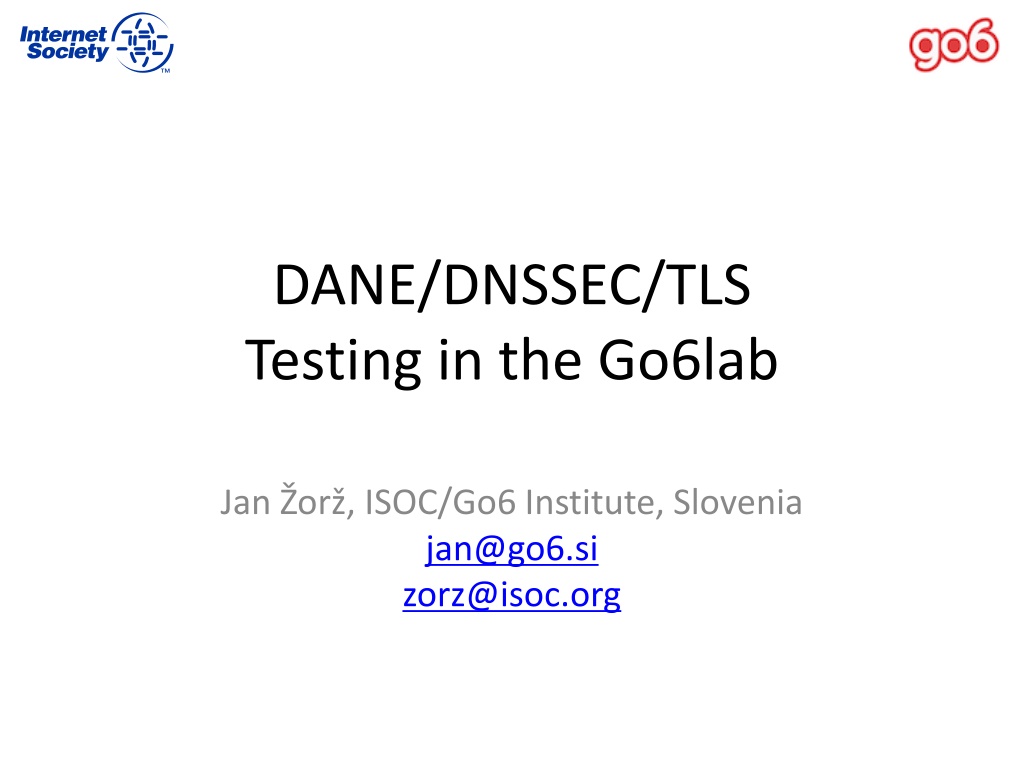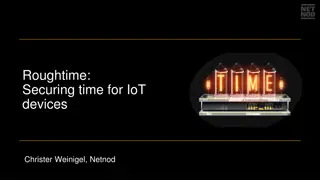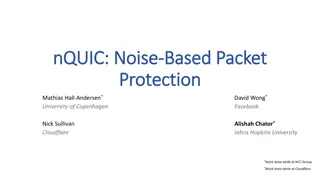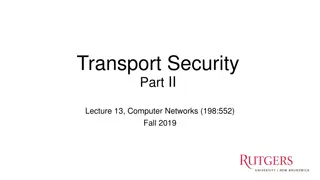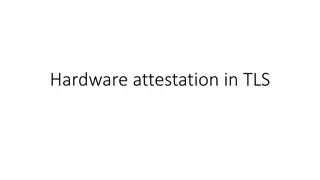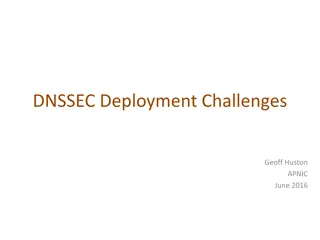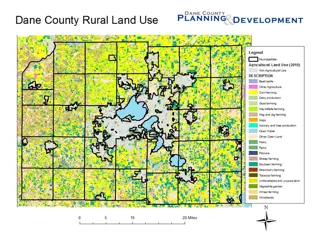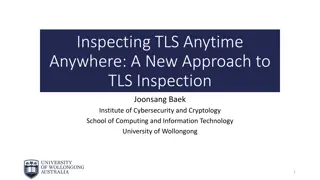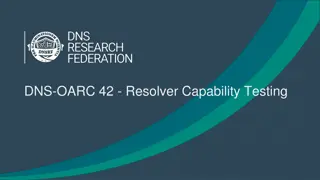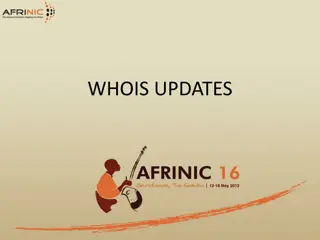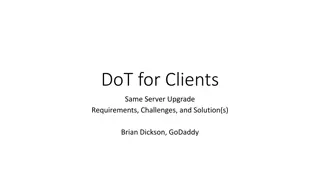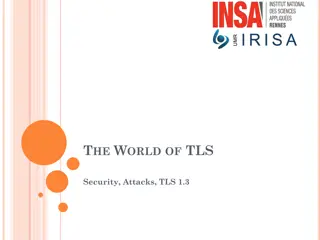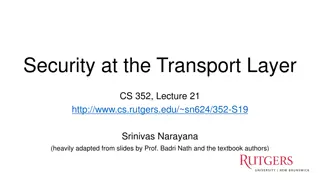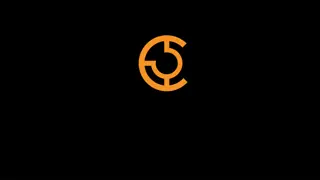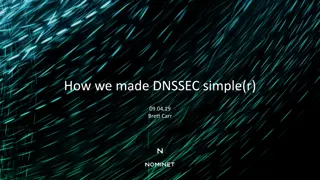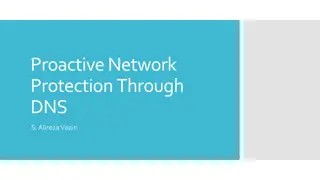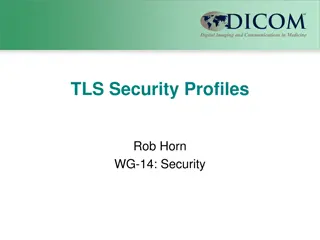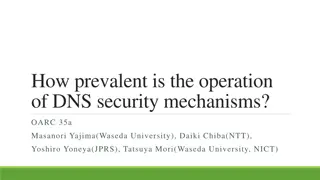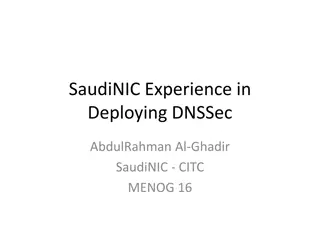Exploring DANE, DNSSEC, and TLS in Go6Lab
Delve into the implementation of DANE, DNSSEC, and TLS protocols at Go6Lab, a testing facility affiliated with ISOC/Go6 Institute in Slovenia. The setup includes DNSSEC implementation with PowerDNS and OpenDNSSEC, DANE experimentation with Postfix servers, and verification processes for TLS certificates. The integration of these mechanisms aims to enhance internet security and reliability in the digital era.
Download Presentation

Please find below an Image/Link to download the presentation.
The content on the website is provided AS IS for your information and personal use only. It may not be sold, licensed, or shared on other websites without obtaining consent from the author. Download presentation by click this link. If you encounter any issues during the download, it is possible that the publisher has removed the file from their server.
E N D
Presentation Transcript
DANE/DNSSEC/TLS Testing in the Go6lab Jan or , ISOC/Go6 Institute, Slovenia jan@go6.si zorz@isoc.org
Acknowledgement I would like to thank Internet Society to let me spend some of my ISOC working time in go6lab and test all this new and exciting protocols and mechanisms that makes Internet a bit better and more secure place
DNSSEC implementation in go6lab Powerdns server (used as primary for non- signed domains) as hidden primary DNS server OpenDNSSEC platform for signing domains BIND9 DNS servers as secondaries to OpenDNSSEC to serve signed zones Virtualization used: PROXMOX 3.4 OS templates: fedora-20, Centos6/7
DNSSEC implementation in go6lab Bump in a wire Two public primary servers Concept:
DNSSEC in go6lab That was fairly easy and it works very well. Implementation document used from Matthijs Mekking: http://go6.si/docs/opendnssec-start-guide-draft.pdf
DANE experiment When DNSSEC was set up and functioning we started to experiment with DANE (DNS Authenticated Name Entities). Requirements: DNSSEC signed domains Postfix server with TLS support > 2.11 We decided on Postfix 3.0.1
DANE TLSA record for mx.go6lab.si _25._tcp.mx.go6lab.si. IN TLSA 3 0 1 B4B7A46F9F0DFEA0151C2E07A5AD7908F4C8B0050E7CC 25908DA05E2 A84748ED It s basically a hash of TLS certificate on mx.go6lab.si More about DANE: http://www.internetsociety.org/deploy360/resources/da ne/
DANE verification Mx.go6lab.si was able to verify TLS cert to T-2 mail server and nlnet-labs and some others mx postfix/smtp[31332]: Verified TLS connection established to smtp-good-in-2.t-2.si[2a01:260:1:4::24]:25: TLSv1 with cipher DHE-RSA-AES256-SHA (256/256 bits) dicht postfix/smtp[29540]: Verified TLS connection established to mx.go6lab.si[2001:67c:27e4::23]:25: TLSv1.2 with cipher ECDHE-RSA-AES256-GCM-SHA384 (256/256 bits)
Postfix config smtpd_use_tls = yes smtpd_tls_security_level = may smtpd_tls_key_file = /etc/postfix/ssl/server.pem smtpd_tls_cert_file = /etc/postfix/ssl/server.pem smtpd_tls_auth_only = no smtpd_tls_loglevel = 1 smtpd_tls_received_header = yes smtpd_tls_session_cache_timeout = 3600s smtp_tls_security_level = dane smtp_use_tls = yes smtp_tls_note_starttls_offer = yes smtp_tls_loglevel = 1 tls_random_exchange_name = /var/run/prng_exch tls_random_source = dev:/dev/urandom tls_smtp_use_tls = yes
Malformed TLSA record We created a TLSA record with a bad hash (one character changed) Postfix failed to verify it and refused to send a message mx postfix/smtp[1765]: Untrusted TLS connection established to mail-bad.go6lab.si[2001:67c:27e4::beee]:25: TLSv1.2 with cipher ECDHE-RSA-AES256-GCM-SHA384 (256/256 bits) mx postfix/smtp[1765]: 3A4BE8EE5C: Server certificate not trusted
1M top Alexa domains and DANE We fetched top 1 million Alexa domains and created a script that sent an email to each of them ( test-dnssec-dane@[domain] ) After some tweaking of the script we got some good results Then we built a script that parsed mail log file and here are the results:
Results Out of 1 million domains, 992,232 of them had MX record and mail server. Nearly 70% (687,897) of all attempted SMTP sessions to Alexa top 1 million domains MX records were encrypted with TLS Majority of TLS connections (60%) were established with trusted certificate 1,382 connections where remote mail server announced TLS capability failed with "Cannot start TLS: handshake failure"
More results TLS established connections ratios are: Anonymous: 109.753 Untrusted: 167.063 Trusted: 410.953 Verified: 128 Quick guide: Anonymous (opportunistic TLS with no signature), Untrusted (peer certificate not signed by trusted CA), Trusted (peer certificate signed by trusted CA) and Verified (verified with TLSA by DANE).
DANE Verified Verified: 128 !!!
Mail distribution Mail Servers # Domains Handled TLS State google.com 125,422 Trusted secureserver.net 35,759 Some Trusted, some no TLS at all qq.com 11,254 No TLS Yandex.ru 9,268 Trusted Ovh.net 8.531 Most Trusted, with redirect servers having no TLS at all
Mail distribution Mail Servers # Domains Handled TLS State Emailsrvr.com 8,262 Trusted Zohomail.com 2.981 Trusted Lolipop.jp 1.685 No TLS Kundenserver.de 2,834 Trusted Gandi.net 2,200 Anonymous
DNSSEC? DANE? None of these big mail servers (and their domains) are DNSSEC signed (that meant no DANE for them possible up to January 2016).
When do DANE things fail? Of course, with wrong certificate hash in TLSA record (refuses to send mail) If domain where MX record resides is not DNSSEC signed (can t trust the data in MX, so no verification) If TLSA record published in non-DNSSEC zone (can t trust the data in TLSA, so no verification)
When do things fail? (example) go6lab.si zone is signed, so is mx.go6lab.si there is TLSA for mx.go6lab.si, also signed Domain signed.si is signed and MX points to mx.go6lab.si Domain not-signed.si is not signed and MX points to mx.go6lab.si We send email to jan@signed.si and jan@not- signed.si (signed.si and not-signed.si are used just as examples)
When do things fail? (example) When I send email to jan@signed.si (signed domain): Verified TLS connection established to mx.go6lab.si[2001:67c:27e4::23]:25: When I send email to jan@not-signed.si (not signed domain): Anonymous TLS connection established to mx.go6lab.si[2001:67c:27e4::23]:25:
When do DANE verification also fail? Let s try to point MX record from signed domain to A/AAAA record in not-signed domain with TLSA that is also not signed (obviously) mail.not-signed.si Send mail to jan@signed.si when MX for signed.si points to mail.not-signed.si DANE verification is not even started as chain of trust is broken
Postfix latest improvements postfix-3.1-20160103/HISTORY: 20160103 Feature: enable DANE policies when an MX host has a secure TLSA DNS record, even if the MX DNS record was obtained with insecure lookups. The existence of a secure TLSA record implies that the host wants to talk TLS and not plaintext. This behavior is controlled with smtp_tls_dane_insecure_mx_policy (default: "dane", other settings: "encrypt" and "may"; the latter is backwards-compatible with earlier Postfix releases). Viktor Dukhovni.
Lets Encrypt, DANE and mail Let s Encrypt recommends using 2 1 1 and 3 1 1 records Validity of LE cert is 90 days By default the underlying key is changed when renewing so also cert hash is changed So, lot s of work if you plan to publish 3 1 1 TLSA using the 2 1 1 method leads to another issue namely lack of an DST Root CA X3 certificate in the fullchain.pem file provided by the Let s Encrypt client So we need to fetch the DST Root CA X3 certificate and add it to fullchain.pem file and verify that it did not change from previous time we renewed
Script to add DST Root CA X3 lynx --source https://www.identrust.com/certificates/trustid/ root-download-x3.html | grep -v "\/textarea" | awk '/textarea/{x=NR+18;next}(NR<=x){print}' | sed -e '1i-----BEGIN CERTIFICATE-----\' | sed -e '$a-----END CERTIFICATE-----\' >> /etc/letsencrypt/live/mx.go6lab.si/fullchain.pem
But At next certificate renew, by default underlying key will change and 3 1 1 TLSA record will become invalid Labor wise, we need to keep the underlying key through the renewals --csr option in letsencrypt-auto client In direcotry examples there is generate- csr.sh file
Stable underlying key ./generate-csr.sh mx.go6lab.si Generating a 2048 bit RSA private key ................+++ ..+++ writing new private key to 'key.pem' ----- You can now run: letsencrypt auth --csr csr.der
Renewals and hashes Now we are using the same underlying key for automatic renewals of certificate, so hash does not change and 3 1 1 TLSA record works. We ll rotate the underlying key when we decide to and being driven by human intervention (and also change the TLSA). ./letsencrypt-auto certonly -t --debug --renew -a standalone --csr ./mx.go6lab.si.der keep Of course, we add DST Root CA X3 certificate to fullchain.pem
More reading: http://www.internetsociety.org/deploy360/blog /2016/01/lets-encrypt-certificates-for-mail- servers-and-dane-part-1-of-2/ http://www.internetsociety.org/deploy360/blog /2016/03/lets-encrypt-certificates-for-mail- servers-and-dane-part-2-of-2/
Conclusions 70% of email can be encrypted in some way, you just need to enable TLS on your server Low number of DNSSEC signed domains/servers Even lower number of DANE/TLSA verified servers/connections It s easy, go and do it it s not the end of the world and it helps with verifying who are you sending emails to and vice versa ;)
Conclusions II. DANE verification failed (or was aborted) if DNSSEC chain of trust is not fully established and complete along the whole way. TLSA in not-signed DNS zones would not help you much preventing your correspondents sending emails to server-in-the-middle (if you are not running latest bleeding edge development version of Postfix) DNSSEC/DANE is easy, but please understand what are you doing before implementing it in production
Q&A Questions? Protests? Suggestions? Complaints? jan@go6.si zorz@isoc.org
